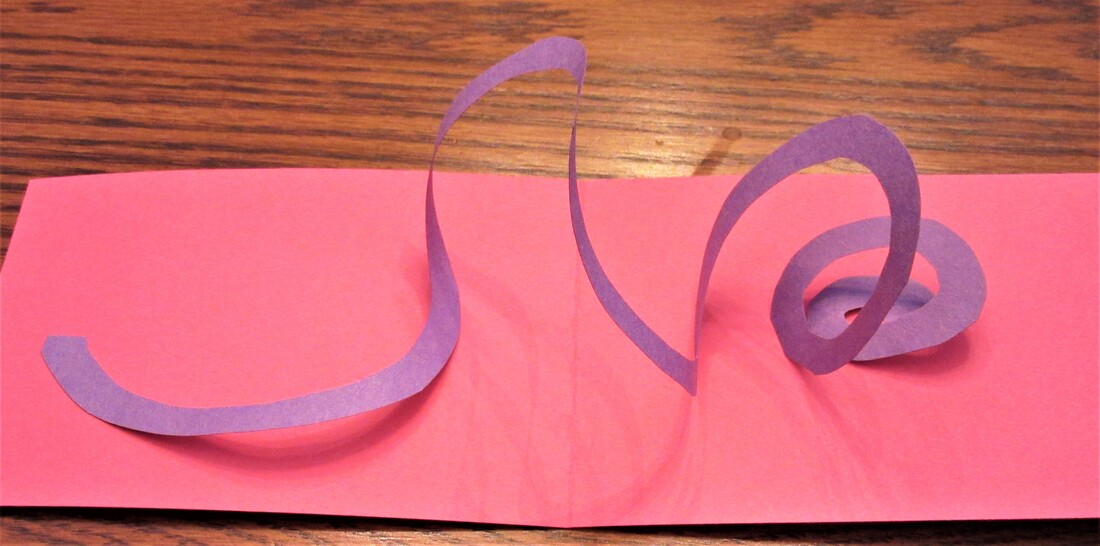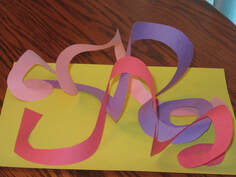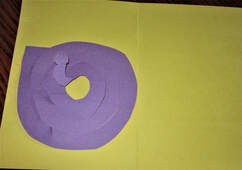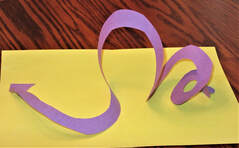 A simple spiral pop-up card.
A simple spiral pop-up card. Here, I’ll provide a simple hands-on project that you may use at home if your family is staying home for Labor Day or that you may use in the classroom on Tuesday after Labor Day—or any day. Making cards to send to a nursing home, or to older relatives, or to anyone who might need a card to brighten their day is an excellent way to teach children how to give kindness to others. When we share kindness with others, it improves our own mental wellness.
 This is an example of what 3 spirals on one card will look like. Be brave.
This is an example of what 3 spirals on one card will look like. Be brave. The only supplies you need are construction paper, scissors, pencil, crayons or markers, and a glue stick. As you can tell from the pictures, we’re making a spiral pop-up card. Spirals are easy enough for a 5-year-old to make. Yet, they can also be challenging enough for high school students, especially if you decide to put three spirals on one card. Making three spirals takes patience.
Step 1: Take a sheet of construction paper, any color, fold it in half to make a book. Set it aside.
Step 2: Next, draw a circle or trace around an object in order to produce a circle. The circle must fit inside your folded page of construction paper.
Step 3: Cut out the circle. Do not worry if the edges are not completely round. The spiral is very forgiving.
Step 4: To make a spiral, you may either cut free hand or use your pencil and draw the spiral first. Then, cut along the lines you have drawn. You want the spiral to be thin so it will pop up easily, but not so thin that it breaks. Small children will need you to draw the spiral on their circle for them. Then, they can cut along the line that you have drawn and make a spiral. If you are using this idea for an entire class of students, photocopy a spiral for the children to cut out—use colored photocopy paper if possible.
 Place the spiral flat on one half of folded card.
Place the spiral flat on one half of folded card. Step 6: Use only a glue stick. Liquid glue will cause everything to glue shut—no pop-up.
Step 7: Place a dab of glue on the top of one end of the spiral. Then, place a dab of glue on the underneath side of the other end of the spiral. Close the construction paper book. Press down firmly. Then, open.
 Once you have glued the spiral as directed, then the spiral will open.
Once you have glued the spiral as directed, then the spiral will open. Step 9: Leave the spiral card open and allow to dry. Set aside.
Step 10: Take a second sheet of construction paper, have your child or students, again fold the paper in half like a book. Then, decorate the outside of the front and back cover. Children may draw pictures, write poems, write messages to Grandma, or just color with markers or crayons.
Step 11: Finally, close the spiral card.
Step 12: Slide the closed spiral card inside the decorated cover. Glue the cover that the child has just colored onto the outside of the spiral card. (Use only a glue stick.) This also helps stiffen the spiral card, allowing it to open and close better.
You are now ready to share your card with others. Have a wonderful day.
 RSS Feed
RSS Feed
